Flowers are not just for gardens—they can transform your meals into visual and flavorful masterpieces. Edible flowers add color, aroma, and a touch of elegance to dishes, making them perfect for garnishing salads, desserts, beverages, and main courses. Beyond aesthetics, many edible flowers also provide subtle flavors and even nutritional benefits, such as antioxidants, vitamins, and minerals.
In this guide, we explore five edible flowers that are perfect for garnishing meals, how to use them safely, and tips for growing them at home to ensure a steady supply.
Why Use Edible Flowers in Your Cooking
Edible flowers are a fusion of art and cuisine. They enhance dishes in several ways:
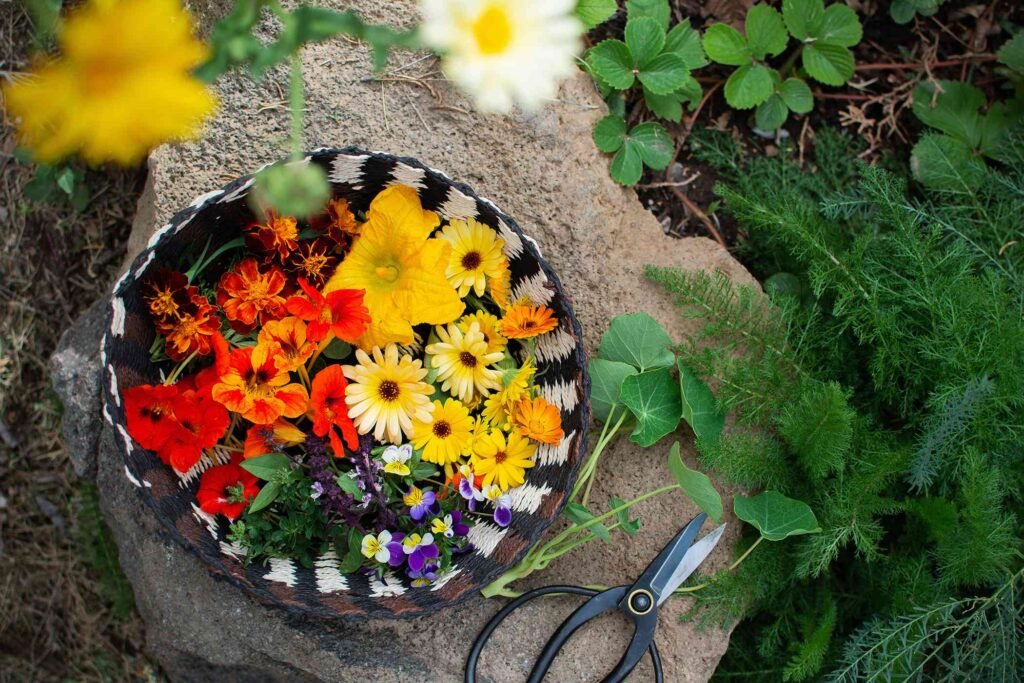
- Visual Appeal – Flowers instantly elevate the presentation of any dish, making meals look sophisticated and vibrant.
- Flavor Enhancement – Many edible flowers add subtle tastes, from sweet and floral to tangy or peppery, complementing different dishes.
- Nutritional Boost – Flowers such as nasturtiums and violets contain vitamins and antioxidants that contribute to a healthy diet.
- Aromatic Appeal – Flowers add delicate scents that enhance the dining experience.
Knowing which flowers are safe and how to use them is crucial. Always ensure they are grown without pesticides and are truly edible, as some garden flowers can be toxic.
1. Nasturtium (Tropaeolum majus): Vibrant and Peppery
Nasturtiums are among the most popular edible flowers due to their bright colors and distinctive taste.
- Appearance – Vibrant orange, red, and yellow blooms.
- Flavor – Slightly peppery, similar to watercress, making them ideal for salads, garnishing cheese plates, or adding a spicy note to dishes.
- Nutritional Benefits – High in vitamin C and antioxidants, supporting immune health.
- Usage Tips – Both flowers and leaves are edible. Sprinkle blossoms over salads, pasta, or roasted vegetables for visual contrast and a peppery punch.
Growing Tips: Nasturtiums thrive in sunny spots with well-draining soil. Deadheading spent flowers encourages more blooms throughout the season.
2. Viola and Pansies: Delicate and Sweet
Violas and pansies offer delicate beauty and subtle sweetness.
- Appearance – Small, multi-colored flowers in shades of purple, yellow, and white.
- Flavor – Mildly sweet and slightly grassy, perfect for adding a gentle floral note to desserts and beverages.
- Nutritional Benefits – Rich in antioxidants and vitamin C, supporting overall health.
- Usage Tips – Use as garnishes for cakes, cupcakes, ice creams, or infused in drinks like lemonade or cocktails.
Growing Tips: Violas and pansies prefer cooler weather and partial sun. Pinch off spent blooms to prolong flowering and maintain plant vigor.
3. Calendula (Calendula officinalis): Sunshine on a Plate
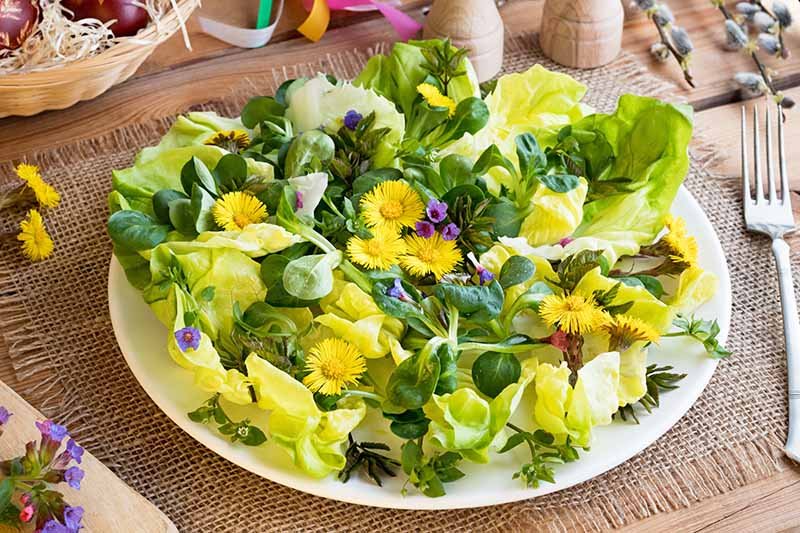
Calendula, also known as pot marigold, is a cheerful edible flower with both culinary and medicinal uses.
- Appearance – Bright orange to deep yellow petals.
- Flavor – Slightly tangy, peppery, or savory, similar to saffron when used dried.
- Nutritional Benefits – High in antioxidants, vitamins A and C, and anti-inflammatory compounds.
- Usage Tips – Sprinkle fresh petals over salads, soups, risottos, or savory dishes for color and flavor. Dried petals can be used as a saffron substitute or in teas.
Growing Tips: Calendula grows well in full sun with moderate watering. Deadhead regularly to encourage continuous blooms.
4. Borage (Borago officinalis): Star-Shaped Wonders
Borage is known for its unique blue, star-shaped flowers and subtle cucumber-like flavor.
- Appearance – Striking blue, star-shaped blooms, sometimes with hints of purple.
- Flavor – Mild cucumber taste, excellent for refreshing salads and beverages.
- Nutritional Benefits – Contains vitamins A and C, as well as minerals like calcium and potassium.
- Usage Tips – Ideal for garnishing cocktails, iced teas, lemonade, or summer salads. Young leaves are also edible but slightly hairy—use sparingly.
Growing Tips: Borage thrives in full sun and well-draining soil. Self-seeds easily, ensuring a perennial supply if left to drop seeds at the end of the season.
5. Lavender (Lavandula angustifolia): Fragrant Elegance
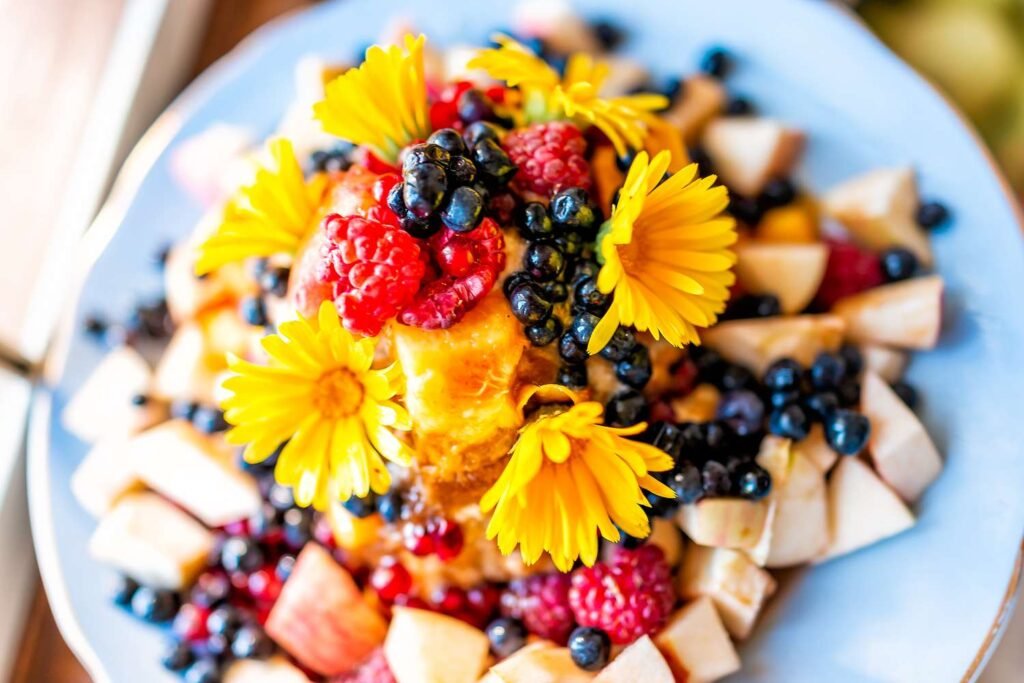
Lavender is a culinary favorite for desserts and beverages due to its calming fragrance and elegant appearance.
- Appearance – Small purple flower spikes with a silvery-green stem.
- Flavor – Sweet, floral, and slightly minty, complementing baked goods, ice creams, and teas.
- Nutritional Benefits – Contains antioxidants and compounds that may promote relaxation and digestive health.
- Usage Tips – Use sparingly to avoid overpowering flavors. Perfect for infusing syrups, decorating cakes, or adding a subtle floral note to lemonade.
Growing Tips: Lavender prefers full sun and well-draining soil. Prune after flowering to encourage bushy growth and more blooms.
Tips for Using Edible Flowers Safely
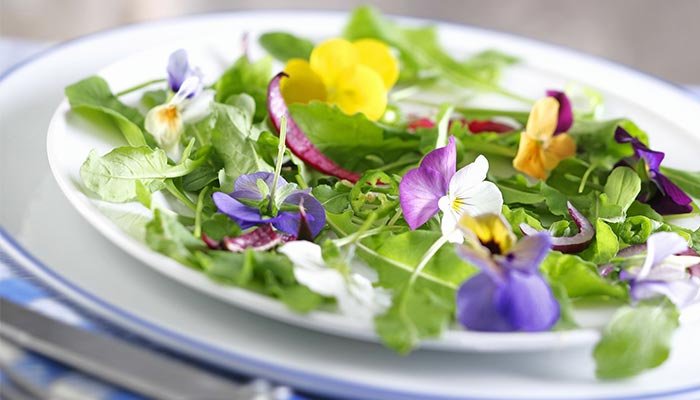
- Source Carefully – Only use flowers grown for culinary purposes. Avoid flowers from nurseries treated with pesticides.
- Wash Gently – Rinse flowers lightly in cold water to remove dust and insects.
- Harvest at the Right Time – Pick flowers in the morning for peak flavor and color.
- Store Properly – Keep fresh flowers in a damp paper towel in the refrigerator for short-term use. Freeze or dry if you need long-term storage.
- Experiment with Flavors – Combine different edible flowers for layered visual and flavor effects, pairing peppery, sweet, and mild-tasting blooms strategically.
Creative Ways to Garnish Meals with Edible Flowers
- Salads: Add nasturtium or borage flowers for color and subtle flavor.
- Desserts: Sprinkle violas or pansies on cupcakes, tarts, or pavlovas.
- Beverages: Lavender and borage flowers are perfect for infusing water, lemonade, or cocktails.
- Savory Dishes: Calendula petals enhance soups, risottos, and roasted vegetables visually and nutritionally.
- Cheese Plates: Mix colorful petals with cheeses, nuts, and fruits for a gourmet touch.
Common Mistakes to Avoid
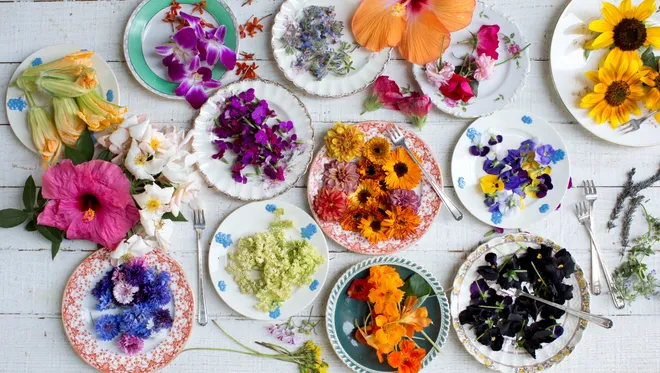
- Using Non-Edible Flowers – Some garden flowers like foxglove or oleander are toxic. Always confirm edibility.
- Overharvesting – Avoid stripping too many flowers from a plant at once; leave enough blooms for continued growth.
- Overpowering Dishes – Some flowers, like lavender or nasturtium, have strong flavors—use sparingly.
- Using Flowers Sprayed with Chemicals – Only use organically grown flowers or those specifically labeled edible.
Conclusion
Edible flowers are a beautiful and flavorful addition to any meal, combining aesthetics with subtle taste and nutritional benefits. The five flowers highlighted—nasturtium, violas/pansies, calendula, borage, and lavender—offer a range of colors, flavors, and aromas that make them ideal for garnishing both savory and sweet dishes.
By growing your own edible flowers or sourcing them carefully, you can elevate your culinary creations with vibrant colors, delicate flavors, and enhanced presentation. Using edible flowers is not just about decoration—it’s about creating a multi-sensory dining experience that combines taste, sight, and aroma.
With the right selection, careful harvesting, and thoughtful plating, edible flowers can transform everyday meals into gourmet experiences that impress guests and delight the senses.
